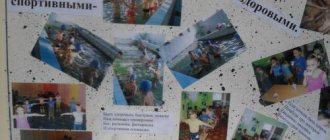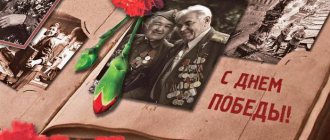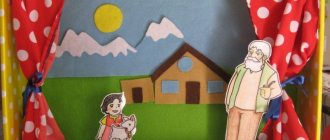Planning in kindergarten: what does it include?
The teacher who is preparing the project must refer to a specific plan. Here is an example of one of these:
- Studying children's problems and forming goals.
- Formation of a plan to achieve the set goal (necessarily discussed with parents).
- Collaboration with specialists in various fields to implement a plan to achieve the goal.
- Creating a project plan.
- Collection, accumulation of material.
- Selecting the types of activities that will be included in the plan.
- Formation of a list of “homework” for independent work.
- Conducting an open lesson and presentation of the project.
How to choose a topic for a school project
You need to choose a topic that is relevant and interesting. You should be interested in the area of knowledge in which you are completing the project. Otherwise, working on the project will be boring, and protecting it will be difficult.
There are several options for how students choose a topic for their project:
Option 1. Choose one of the topics suggested by the class teacher. Option 2. Choose a school subject and a teacher who will suggest a topic in your subject. Option 3. Come up with a topic yourself. Think about what you, your classmates or adults are missing, and try to formulate a project topic to solve the problem.
Since the result of the project should be a new product , you need to think carefully about what can be created as a result of the project. In the following table we provide examples of what can be done as a project deliverable:
| Project topic | Project product/result |
| Computer games: benefit or harm | Video or computer animation on safe computer work. |
| What do our names mean? | A booklet with the names of classmates and their meanings. |
| History of football | A booklet with a list of football sections that exist in the city. Can be divided into two categories: free and paid. |
| Multiplication table on fingers | A brochure or booklet with multiplication rules on your fingers. Video demonstrating multiplication on fingers. |
| Poets and writers about my hometown | Blog on the Internet dedicated to this topic. Can be created on free platforms (Blogger from Google, https://www.blogger.com). |
| Voiced and voiceless consonants | A program in the Scratch language for testing knowledge of voiced and voiceless consonants. |
| Vegetarianism | Brochure with recipes for vegetarian dishes. Internet blog dedicated to vegetarianism. Can be done on Google's free Blogger platform, https://www.blogger.com. |
By the way, we have a great article on how to make a modern website for a school project yourself!
What does a school project include?
The final product here can be anything: from a wall newspaper to a model of Ancient Rus'. After all, the main thing is to create something completely new for the student, previously unknown to him.
Solving design problems, one way or another, is included in the plan of every lesson in any discipline. The development of large-scale presentations and the practice of defending them are carried out mainly in extracurricular activities.
Ideally, the principle of this approach to training is based on 3 advantages:
- Self-determination
(while working on a project, the student identifies for himself those areas of knowledge that resonate with him the most); - Self-discipline
(through trial and error, the child learns to independently organize his free and working time);
- Self-realization
(having chosen the most interesting direction for himself, the student begins to use his potential as effectively as possible).
In addition, debates during the defense of a project are an extremely useful and exciting process. Even if a child is not destined to become a speaker or scientist, he will still have to present himself both at work and in society.
Types of projects
What projects can be used in kindergarten? Let's look at the main options:
- creative projects that involve researching a problem and demonstrating the results obtained in the form of a theatrical performance;
- role-playing games, in which, to solve a given problem, children act as characters from a fairy tale;
- creative research projects aimed at solving a problem in the form of a newspaper or design;
- informational and practice-oriented options, which involve children collecting information necessary for group design.
When choosing forms of work, the teacher must take into account the individual age characteristics of preschoolers. Children are characterized by increased physical activity, so projects are associated with play activities.
Computer presentation vs stand for project work
The presentation of the project should be not only informative, but also interesting. Along with the computer presentation, which is common in every school, there is a poster demonstration. When the board displays the main points of the study in the form of diagrams, drawings or tables. Such a presentation should not be overloaded with data. She acts only as an assistant to the speaker and the audience.
Are there any significant differences between a computer show and a stand show? No, they are essentially the same thing. It’s just that in the presentation the slides go one after another, and on the stand blocks of information appear sequentially:
- Full name of the author and supervisor;
- Relevance of the presented topic;
- The purpose of the project and criteria for the effectiveness of the project (in the study we talk about confirming the hypothesis);
- Project concept (flowchart of work execution, demonstration of the essence of the research process and its objects: these can be area maps, diagrams, photos of samples and teams);
- Resources used.
If desired, the structure can include a list of references, an evaluation of effectiveness and acknowledgments, if any.
Event plan
The teacher organizes an exhibition for children on the topic “Work in our garden.” Information material is selected for it: postcards, newspaper clippings, educational games, fiction.
A medical worker is preparing a lecture on the benefits of onions for a parent meeting. The teacher chooses message topics with the children on which they will draw up creative works.
After the completion of the project, the results of the activities are summed up, a newspaper is issued, and delicious onion dishes are presented.
The music worker organizes accompaniment for the award ceremony for the best chefs.
Topics of projects in kindergarten and methods of their implementation
The planning method can be applied in the following sequence:
- Goal setting:
the teacher’s task at this stage is to choose a current problem for the child and develop ways to solve it. - Design
- developing a plan to achieve the goal:
- who to turn to for help (an adult, a teacher);
- selection of sources of information on the topic;
- a list of items and equipment that were used;
- what new skills were mastered to achieve the goal.
- Executing the project
is the practical part. - Summing up –
choosing topics and setting tasks for new projects.
Projects are currently classified according to the following criteria:
- by composition of participants;
- by task;
- by topic;
- according to deadlines.
Classification
All projects in kindergarten are divided by duration into:
- short-term (several lessons);
- long-term (during the academic year).
A teacher can work with one child (individual activity) or with a group of preschoolers (team work).
A project in kindergarten in the senior group is an excellent way to involve children in active creative activities. This kind of work contributes to the formation of cognitive interest in preschool children and helps the teacher to build for each pupil.
For example, projects in kindergarten make it possible to correct speech problems in children and develop communication skills.
Application of projects in practice
It is clear that in primary school children do not yet have the skills to independently search for the necessary information. Therefore, to begin with, a game form is suitable for them: simple observation of animals, plants, weather. As children grow older, their project tasks should gradually become more complex. The motivation will be practical experience from real life, namely the opportunity to earn money.
A certain idea is taken as a basis. For example, installing a terminal for charging gadgets on the station area. In this case, it’s not enough to want, you first need to think through everything, and then do it:
- Find out everything about the ways of implementation from the point of view of the law;
- Register as an individual entrepreneur (ask your parents);
- Estimate your chances of success, see what problems may arise and how to deal with them;
- Find a suitable location, as well as a responsible person with whom you need to coordinate the installation, etc.
It is clear that a ninth-grader cannot become an entrepreneur right away. But he will form a specific idea, confirmed by practice, of how he can launch his startup.
In theory, everything sounds attractive, of course, but in reality, teachers face certain difficulties:
- Where should the project start?
- How to motivate students;
- How should this approach be incorporated into the school curriculum without compromising the core base.
Benefits to help
The textbook “Design Workshop”, developed by practitioners A.V., deserves special attention. Leontovich, I.A. Smirnov, A.S. Savvichev. In lively and understandable language, the authors tell teachers and children about the intricacies of design and research activities:
- How to bring a project idea to a successful result;
- How to structure your work;
- Errors and ways to solve them are analyzed using examples;
- Advice is given on how to independently prepare for the delivery of the project.




